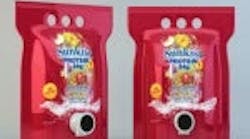With the clamor for convenience and the demand for packaging sustainability showing no signs of weakening, pouches are becoming the go-to package style for an ever broader range of products.
In the baby food category, pouches with rigid closures have been on the scene for several years. However, a new twist on the concept has emerged in the form of a retortable, zippered stand-up pouch.
Sprout Foods Inc., New York, uses this type of package for Sprout organic baby food. The company sells products in three pouch sizes — 2.5-oz., 3.5-oz. and 5.5-oz. — to meet the needs of children in various stages of growth. Ampac, Cincinnati, supplies the pre-made pouches.
When launching the product line, Sprout Foods chose pouches rather than glass jars or rigid plastic packaging for several reasons, including product flavor, convenience and environmental performance. When retorting baby food in a glass jar or rigid plastic tray, "There's no question [the food] is going to lose some of its flavor, because you're overcooking it," says Ron Davis, CEO of Sprout Foods.
In contrast, with a pouch, "You cook it at the same temperature but for less time, so you're not overcooking the outside to sterilize the inside." Davis says cooking time is 25 to 40 percent less with the pouch than with the other packaging formats.
Sprout baby food pouches, which are shelf-stable, have a bottom gusset but a wide opening at the top for easy access by a spoon. After the feeding, they can be reclosed and stored in the refrigerator.
Not overcooking and generally protecting the products' integrity were key considerations for Sprout, which is positioned as a premium brand. Sprout co-founder and executive chef Tyler Florence, of Food Network fame, developed the Sprout baby food recipes. The focus throughout the line is gourmet flavor and healthy, 100 percent organic ingredients.
Sprout's pouches are made from a laminated film. The film's layers, from exterior to interior, are polyester/foil/nylon/polypropylene. The zipper is made of polypropylene, which enables it to stand up to the rigors of retorting.
Some might question the presence of foil in the film; although foil provides oxygen and light protection, it also eliminates the option of microwaving. And that was the point. Sprout's products are designed for serving with minimal reheating, to maintain flavor and nutrients. To warm up the contents of the pouch, consumers "can run it under warm water, if desired, but it can't go in the microwave oven," Davis says.
In addition, the pouch is convenient. Its large opening and bottom gusset provide ample access for a spoon and make it easy to feed directly from the pouch. In case of leftovers, the pouch can be reclosed and stored in the refrigerator; prior to opening, the packages are shelf stable.
The package is lightweight, as well, for easy portability. To provide a straighter tear and easier opening, Ampac incorporated its Linear Tear technology into the pouches.
Safety is yet another benefit. The pouches don't break when dropped, and unlike glass they can't shatter into dangerous shards.
From a marketing standpoint, the rectangular stand-up pouches provide a brand billboard. To communicate Sprout's value proposition, the pouches are decorated with photo-quality rotogravure printing. "The graphics are exceptional," Davis says. "They really stand out on shelf."
Hormel Foods Corp., Austin, Minn., has redesigned the packaging for 20-oz. club-store pouches of Hormel Real Crumbled Bacon to assure package integrity and aesthetics for the life of the product. Ampac supplies the pouch, which incorporates its E-Z Zip technology.
The resealable zipper is on the front panel of the pouch rather than built into the header, and consumers access the zipper by removing a tear strip. The strip comes off cleanly, eliminating the problem of a torn, raggedy looking header.
Hormel's rotogravure-printed graphics, including new brand messaging on the pouch's header, remain in good condition throughout repeated use of the product, reinforcing the brand's quality.
Finally, sustainability played an important role. Based on weight, packaging as a percentage of the product is 6 percent for the pouch—vs. 14 percent for a lidded plastic tray and 70 percent for a glass jar. The pouch's low ratio translates into a lower carbon footprint for Sprout products. The pouches are delivered flat to the processing plant. Therefore, more packages can be loaded onto pallets and trucks, which makes for more carbon savings per package.
But they're not recyclable. To address the package's end of life, Sprout encourages consumers to give used pouches to TerraCycle Inc., Trenton, N.J., for upcycling into new products. Pouches can be mailed to TerraCycle or deposited at its collection centers.
Sunkist Protein, on a grand scaleConvenience, product integrity and packaging sustainability also drove the selection of a large-format stand-up pouch for Sunkist Protein shots. The one-gallon Sunkist Protein pouch, which launched commercially in October 2010, holds 48 servings. The fruit punch-flavored product is sold in single-serving rigid plastic tubes and bottles, as well.
The pouch is an unusual package for protein shots, in terms of both format and size. The one-gallon size offers regular users of the product an economical way to buy Sunkist Protein in bulk, for daily use. It's also handy for nursing homes and other facilities that buy protein shots for the use of their residents.
Sunkist Protein products are manufactured by Protica Inc. in partnership with BioBev LLC, both based in Whitehall, Pa. BioBev is a trademark licensee of Sunkist Growers Inc., Sherman Oaks, Calif.
Although hot-filled products such as Sunkist Protein typically must be refrigerated after opening, the dispenser on the one-gallon pouch makes refrigeration unnecessary. The dispenser eliminates backflow, protecting against bacterial contamination that could affect flavor and food safety.
International Dispensing Corporation, New York, supplies the dispenser, which is called The Answer. Fres-co System USA Inc., Telford, Pa., produces the pre-made Sunkist Protein pouches.
In selecting a package format for the multi-serving protein shots, "We considered bag-in-box, Bettix [dispensing] bottles and other mainstream formats," says Jim Duffy, Protica's president. "The Answer was the reason we decided to use the stand-up pouch. It was the ideal fit to provide shelf stability for the full life cycle of the product."
Duffy adds that consumers "‘get' the value … they love the ability to take the pouch anywhere and never worry about refrigeration." Three die-cut finger holes at the top of the pouch provide a carrying handle.
The Zip360 has a zipper that goes all the way around the rectangular opening. It was introduced at last year's Pack Expo by Zip-Pak, in collaboration with Printpack Inc. and Triangle Package Machinery Co.
Greg Abbott, founder and chief executive officer of IDC, adds that the pouch "gets lighter and smaller as you roll it up. It's a very interactive package. In the end you can squeeze every last drop out, and you have this little piece of plastic."
Abbott adds that the pouch is "much more desirable" environmentally than a one-gallon plastic jug or individual bottles. "If you compare [the pouch] to several single-serve packages, you use far less packaging material per pouch, there's less energy in the production of the whole package and there's dramatically less landfill."
All that and a bag of chipsFor certain foods, such as potato chips and brown sugar, the value of a resealable pouch that provides easy product access and dispensing is a no-brainer. But historically, a pouch that provides all three features has been elusive.
A new package format — a side-gusset, wide-mouth pouch with a zipper that goes all the way around the opening — addresses the need. Dubbed the Zip360, the pouch stands up and has a large enough opening to eat from or dip a measuring scoop into. When closed halfway, the zipper creates a pour spout.
The Zip360 was developed by Zip-Pak, Manteno, Ill., in collaboration with Atlanta-based Printpack Inc. and Chicago-based Triangle Package Machinery Co.
"It's so functional for many different markets," says Elizabeth Sheaffer, marketing manager at Zip-Pak. In addition to chips and sugar, potential applications include cereal, meat snacks, crackers, cookies, pretzels and frozen foods.
Depending on the product, there are "different pain points that consumers are trying to solve with their packaging. You could use this to alleviate some of those concerns," such as product freshness and accessibility, Sheaffer adds.
In addition to functionality, the package format provides ample space for messaging, and the brand stays in front of consumers longer because they don't need to transfer the product to another container.
Consumer packaged goods companies and consumers alike have been asking for this type of package, Sheaffer says: "Across all of our focus groups and all of our discussions with CPGs, it just seems like this is the package that everyone has been wanting and looking for."


